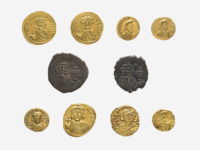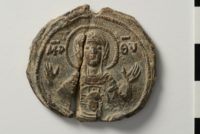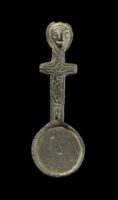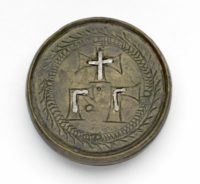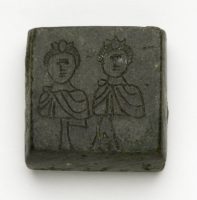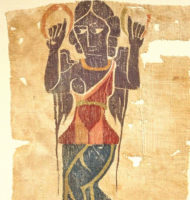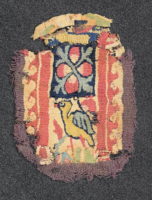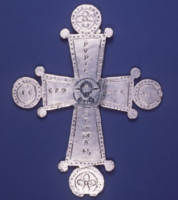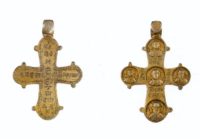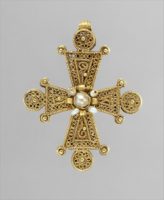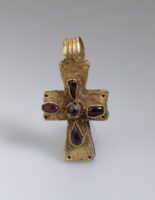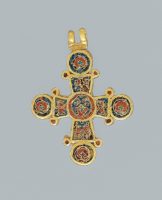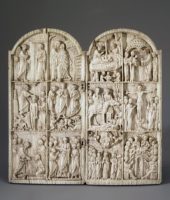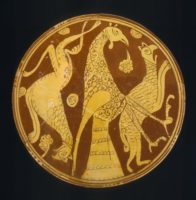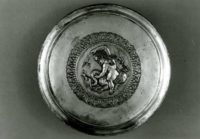Silver coin of Alexander the Great; Greek; Date: 323BC-280BC; Kingdom of Macedonia, Minted in: Anatolia, Turkey (Uncertain mint, Western Asia Minor) Weight: 4.12 grammes. Die-axis: 12 o’clock. British Museum is closed 24, 25 and 26 December and 1 January, but is open every other day of the year. Fast facts about the British Museum: Founded: 1753, Collection size: 8 million objects, Oldest object in the collection: Stone chopping tool (nearly 2 million years old).
Silver Coin, Period: 4 th century B.C. 330BC (circa); Museum Description: “Silver coin.(obverse) Head of nymph Sinope waring earring. (reverse) Eagle above dolphin.” Minted in: Sinope (Modern Turkey, Black Sea Region Sinop Province) British Museum is closed 24, 25 and 26 December and 1 January, but is open every other day of the year. Fast facts about the British Museum: Founded: 1753, Collection size: 8 million objects, Oldest object in the collection: Stone chopping tool (nearly 2 million years old).
Coins; Ruler: Constantine IV; Period: Early Byzantine Period; circa: 654-685; Minted in: Sicily, Italy. Weight: 1.47 grammes. British Museum is closed 24, 25 and 26 December and 1 January, but is open every other day of the year. Fast facts about the British Museum: Founded: 1753, Collection size: 8 million objects, Oldest object in the collection: Stone chopping tool (nearly 2 million years old).
Constantine Xeros, Sebastos. Period: Late Byzantine, 12th.c. second half. Translation: May you, all-holy Virgin, be the keeper and seal of the correspondence of the sebastos Constantine Xeros. The museum is open to the public Tuesday through Sunday, 11:30 a.m.–5:30 p.m., except for federal holidays.
Copper alloy counterpoise coin balance; in the form of a rectangular beam with transverse bar, Late Byzantine (13-14 thc.)
Copper Alloy Weight, Period: Early Byzantine, 6thc-7thc, discoidal with double-grooved convex profile; lathe-turned with rims; face engraved with double wreath enclosing cross above denominational mark, both inlaid with silver. British Museum is closed 24, 25 and 26 December and 1 January, but is open every other day of the year.
Copper alloy weight, Period: Early Byzantine, circa: 4thC-5thC. Quare with convex profile & chamfered lower edges; engraved on face with 2 imperial busts. British Museum is closed 24, 25 and 26 December and 1 January, but is open every other day of the year. Fast facts about the British Museum: Founded: 1753, Collection size: 8 million objects, Oldest object in the collection: Stone chopping tool (nearly 2 million years old).
Coptic Textile fragment, Period: Early Byzantine circa: 4th–6th century A.D. Object Place: Egypt. Materials: Linen plain weave with wool tapestry insert. Dimensions: 34.5 x 65 cm (13 9/16 x 25 9/16 in.).
The MFA is open 7 days a week. Monday and Tuesday 10 am–5 pm, Wednesday–Friday 10 am–10 pm, Saturday and Sunday 10 am–5 pm.
Piece of woollen coptic textile, Period: Early Byzantine. circa: 6th century-8th century. Height: 90 millimetres (max) Width: 63 millimetres (max). British Museum is closed 24, 25 and 26 December and 1 January, but is open every other day of the year. Fast facts about the British Museum: Founded: 1753, Collection size: 8 million objects, Oldest object in the collection: Stone chopping tool (nearly 2 million years old).
Crescent-Shaped Earring, Materials: Gold filigree with cloisonné enamel. Period: Middle Byzantine circa: 1000-1100. Dimensions: 2.3 x 2.6 cm (7/8 x 1 in.). The Cleveland Art Museum Hours: Tuesdays, Thursdays, Saturdays, Sundays 10:00 a.m.–5:00 p.m. Wednesdays, Fridays 10:00 a.m.–9:00 p.m. Closed Mondays.
Crescent-Shaped Pendant, Period: Middle Byzantine; circa: 11th century. Materials: gold filigree with cloisonné enamel. Dimensions: 3 x 3.2 cm (1 3/16 x 1 1/4 in.). The Cleveland Art Museum Hours: Tuesdays, Thursdays, Saturdays, Sundays 10:00 a.m.–5:00 p.m. Wednesdays, Fridays 10:00 a.m.–9:00 p.m. Closed Mondays.
Cross of Romanos II and Basil II, Period: Middle Byzantine, Date: 960-963. Materials: silver and niello. Purchased by Mildred and Robert Woods Bliss from George Zacos (dealer) Istanbul, July 24th, 1953; Gift of Milderd and Robert Woods Bliss to Dumbarton Oaks Research Library and Collection, Washington, DC, 1953; The museum is open to the public Tuesday through Sunday, 11:30 a.m.–5:30 p.m., except for federal holidays.
Pectoral cross with busts of Jesus Christ and saints, silver-gilt. On the reverse, the engraved inscription refers to its owner: Epiphanios. Period: Middle Byzantine; circa: 11th c. The Benaki Museum of Greek Culture is housed in one of the most beautiful neoclassical-style buildings in Athens, near the National Garden and the Hellenic Parliament.
Cross with Pearls, Period: Late Byzantine, circa: 1200–1400. Materials: Gold and pearls. On view at The Met Fifth Avenue in Gallery 303. The Metropolitan Museum of Art (New York) is one of the world’s largest and finest art museums. Its collection includes more than two million works of art spanning five thousand years of world culture, from prehistory to the present and from every part of the globe. Public Hours: 10:30 a.m.–5:30 p.m. Open seven days a week.
Cross, Period: Early Byzantine, circa: 5th-6th century, Materials: golad and garnet. Dimensions: 3,8×1,9 cm. The collection of the State Hermitage includes over 3 million works of art and world culture artefacts. It contains paintings, graphic works, sculptures, works of applied art, archaeological artefacts and numismatic objects. The Hermitage is considered to have been founded in 1764, when Empress Catherine the Great acquired an impressive collection of works from the Berlin merchant Johann Ernst Gotzkowsky. The museum celebrates the anniversary of its founding each year on 7 December, St. Catherine’s Day. Opening Hours: Tuesday, Thursday, Saturday, Sunday: 10.30-18.00 Wednesday, Friday: 10.30-21.00 Closed: Monday.
Cross, Period: Early Byzantine, circa: 6th c. Made in: Constantinople. Material: gold. Dimensions: 5х3 cm. The collection of the State Hermitage includes over 3 million works of art and world culture artefacts. It contains paintings, graphic works, sculptures, works of applied art, archaeological artefacts and numismatic objects. The Hermitage is considered to have been founded in 1764, when Empress Catherine the Great acquired an impressive collection of works from the Berlin merchant Johann Ernst Gotzkowsky. The museum celebrates the anniversary of its founding each year on 7 December, St. Catherine’s Day. Opening Hours: Tuesday, Thursday, Saturday, Sunday: 10.30-18.00 Wednesday, Friday: 10.30-21.00 Closed: Monday.
Cross, Period: Middle Byzantine, circa: 1100, Made in Constantinople, Materials: Cloisonne enamel (red and blue). Dimensions: 15/16 x 7/8 x 1/8 in. (2.36 x 2.07 x 0.31 cm). On view at The Met Fifth Avenue in Gallery 303 . The Metropolitan Museum of Art (New York) is one of the world’s largest and finest art museums. Its collection includes more than two million works of art spanning five thousand years of world culture, from prehistory to the present and from every part of the globe. Public Hours: 10:30 a.m.–5:30 p.m. Open seven days a week.
Diptych Showing Twelve Festive Scenes, Period: Middle Byzantine, circa: Late 10th century. Material: ivory. Dimensions: 26,4×13,3 cm. The collection of the State Hermitage includes over 3 million works of art and world culture artefacts. It contains paintings, graphic works, sculptures, works of applied art, archaeological artefacts and numismatic objects. The Hermitage is considered to have been founded in 1764, when Empress Catherine the Great acquired an impressive collection of works from the Berlin merchant Johann Ernst Gotzkowsky. The museum celebrates the anniversary of its founding each year on 7 December, St. Catherine’s Day. Opening Hours: Tuesday, Thursday, Saturday, Sunday: 10.30-18.00 Wednesday, Friday: 10.30-21.00 Closed: Monday.
Dish of brown, fine-grained clay covered with a white slip. Period: Middle Byzantine; circa: Late 12th-early 13th c. The decoration is in champlevé, while the individual details are incised. A large standing bird is pictured between two bird-shaped animals resembling griffons but without wings. Dimensions: H. 0.07, Diam. of rim 0.235, Diam. of base 0.08 m. On the ground tufted plants. Yellow, very good quality glaze covers the inner surface and the edge of the rim on the outside. The Benaki Museum of Greek Culture is housed in one of the most beautiful neoclassical-style buildings in Athens, near the National Garden and the Hellenic Parliament.
Silver Dish; Period: Early Byzantine. 6th.c.(late) on a shallow foot; the centre decorated with Eros astride a ketos (sea monster) which he attacks with a trident. Found/Acquired: Anatolia, Modern Turkey. British Museum is closed 24, 25 and 26 December and 1 January, but is open every other day of the year. Fast facts about the British Museum: Founded: 1753, Collection size: 8 million objects, Oldest object in the collection: Stone chopping tool (nearly 2 million years old).




